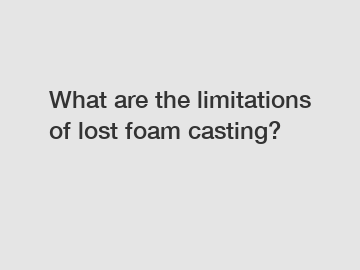Mar. 27, 2024
Lost foam casting is a popular method used in the metal casting industry for creating complex, intricate, and precise metal parts. This process involves creating a foam pattern of the desired part, coating it with refractory material, and then pouring molten metal into the mold to replace the foam pattern. While this method offers numerous advantages, it also comes with several limitations that need to be considered. Understanding these limitations is crucial for ensuring the success and quality of lost foam casting projects.
**Pattern production limitations**.
One of the key limitations of lost foam casting is related to pattern production. Creating intricate foam patterns can be time-consuming and costly. The production of foam patterns requires specialized equipment and skilled labor, which can add to the overall cost of the casting process. Additionally, the quality and durability of foam patterns may vary, leading to potential defects and inaccuracies in the final metal part. It is essential to carefully assess the complexity and size of the pattern before proceeding with lost foam casting to avoid potential production issues.

**Material limitations**.
Another limitation of lost foam casting is related to the limitations of materials used in the process. The properties of the foam material used to create the pattern can impact the final quality of the metal part. Certain types of foam may not be suitable for intricate or large-scale parts, leading to issues such as shrinkage, warping, or deformation during the casting process. Additionally, the refractory coating applied to the foam pattern must be carefully selected to withstand the high temperatures and pressures involved in the casting process. Failure to choose the right materials can result in defects and inconsistencies in the final metal part.
**Dimensional accuracy limitations**.
Dimensional accuracy is a critical aspect of lost foam casting, as it determines the overall quality and functionality of the final metal part. However, achieving tight tolerances and precise dimensions can be challenging with this casting method. Factors such as foam pattern shrinkage, thermal expansion of the molten metal, and variations in the casting process can affect the dimensional accuracy of the final part. It is important to carefully control these variables and implement measures to minimize dimensional variations during the casting process.
**Surface finish limitations**.
Surface finish is another important consideration in lost foam casting, especially for applications where visual aesthetics or functional requirements are critical. The surface quality of the final metal part is influenced by numerous factors, including the quality of the foam pattern, the effectiveness of the refractory coating, and the casting process parameters. Inadequate surface finish can lead to defects such as roughness, porosity, or uneven texture, affecting the overall quality and performance of the metal part. Careful attention must be paid to surface finish requirements when planning and executing lost foam casting projects.
In conclusion, lost foam casting offers a range of benefits for producing complex and detailed metal parts. However, it also comes with limitations that must be carefully considered and addressed to ensure successful outcomes. By understanding and mitigating the limitations related to pattern production, materials, dimensional accuracy, and surface finish, manufacturers can maximize the advantages of lost foam casting while minimizing potential drawbacks. Contact us today to learn more about lost foam casting and how it can benefit your metal casting projects.
Want more information on oem grey iron sand casting suppliers, heat treatment of gray cast iron, oem grey iron sand casting parts companies? Feel free to contact us.
Previous: Essential Guide to Metal Spiral Staircase Dimensions & Sizing
Next: None
If you are interested in sending in a Guest Blogger Submission,welcome to write for us!
All Comments ( 0 )